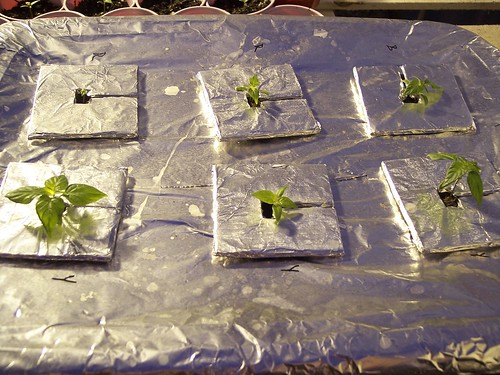So since I now have two completely different controlled environments to start plants, I decided it was time to run an experiment. I know there has been alot of talk about lighting setups recently so I came up with an experiment that can provide some insight and not interfere with this years grow.
Here is what know about my grow room from last years grow:
Here is a little information about my greenhouse
Experiment set up
Hypothosises
Now for the pics! I know you are all waiting.
Growroom ( haven't placed all three set of plants in yet, have to pick up more cups tomorrow )

100_0728 by GhostPepperStore.com, on Flickr

100_0729 by GhostPepperStore.com, on Flickr
<strong>Greenhouse </strong>

100_0732 by GhostPepperStore.com, on Flickr

100_0730 by GhostPepperStore.com, on Flickr
My ultimate plan is to move the plants from the growroom to the greenhouse as a hardening off method since the polycarbonate only allows 78% light transmission and I can easily shade them in there if neccesary.
I would love any feedback as it is much easier to adjust an experiment in the beginning rather than the end.
Here is what know about my grow room from last years grow:
- 8 T8 bulbs 32W each, (4) 6500K (2) 4100K (2) 3000K mounted on frame with a pulley system to adjust height
- 20/4 light cycle, constant temperature of 82 F, variable humidity usually 30-40%
- Last years plants had a lot of trouble being hardened off, mostly due to my work schedule. First week of 4 hours outside they got severly burned
- I am able to comfortably house 72 plants in 1 gallon containers in the 6x6 area.
Here is a little information about my greenhouse
- 14x16 8mm polycarbonite, 20,000 BTU NG Heater, 1000W HPS bulb runs 3 hours a day to give me a 14/10 light cycle
- Variable temperature, environmental controls set to hold 65 F or above at night 85 F or less during the day, humidity generally 80% at night 30% during the day
Experiment set up
- I will be watching three groups of plants. 32 Bhut Jolokia Red, 16 Bhut Jolokia Yellow and 16 Bhut Jolokia Chocolate in each system.
- All seeds were germinated in the greenhouse in Jiffy 7s then transplanted to Dr. Earth Organic planting mix. Plants are all generally at the same size 1-2 sets of true leaves.
- Plants will all receive same watering and nutrient schedule if at all possible. Watering likely will need adjusted for each system
- Update progress weekly
Hypothosises
- Greenhouse system will be more effective overal(considering the size of the investment, it better be)
- Grow room system will have less pest issues, due to be sterilized beforehand and having no soils from outside anywhere near it.
- Greenhouse plants will have little or no problems with hardening
Now for the pics! I know you are all waiting.
Growroom ( haven't placed all three set of plants in yet, have to pick up more cups tomorrow )

100_0728 by GhostPepperStore.com, on Flickr

100_0729 by GhostPepperStore.com, on Flickr
<strong>Greenhouse </strong>

100_0732 by GhostPepperStore.com, on Flickr

100_0730 by GhostPepperStore.com, on Flickr
My ultimate plan is to move the plants from the growroom to the greenhouse as a hardening off method since the polycarbonate only allows 78% light transmission and I can easily shade them in there if neccesary.
I would love any feedback as it is much easier to adjust an experiment in the beginning rather than the end.








